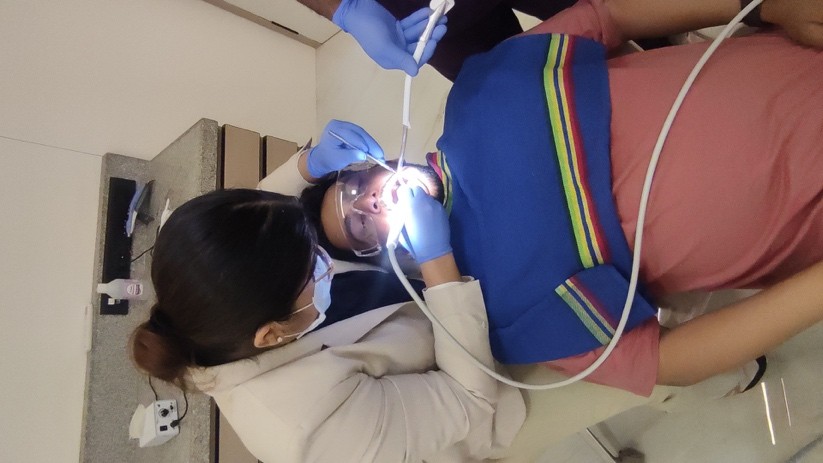Swelling after Root Canal

Oral health is a vital part of your overall wellbeing, and timely dental treatment can prevent long-term complications. However, even the most standard procedures like root canals may sometimes cause unexpected side effects.
According to the Indian Dental Association, over 10 million root canals are performed annually in India, and nearly 15–20% of patients experience some form of swelling or post-treatment discomfort. Globally, studies estimate around 60% of patients report mild to moderate swelling after root canal in the first week.
Dr. Ankita Gehi, an acclaimed Prosthodontist at Aakaar Dentistry, a cutting-edge and trusted dental clinic in Bandra, says:
“Swelling after root canal isn’t always a sign that something is wrong. It is often just the body’s natural inflammatory response to the procedure. However, it is important for patients to recognize the signs that differentiate normal healing from something that needs attention. Clear post-treatment guidance and early dental follow-ups are key to smooth recovery.”
This blog will explore why swelling occurs, when it becomes a concern, and how you can manage it safely.
How long does the swelling after root canal last?
Mild to moderate swelling is a normal response to root canal therapy, especially in the first few days. But understanding the typical duration of swelling can help ease your dental anxiety and avoid unnecessary panic.

Here’s what you can expect:
- Immediate swelling (within 24-48 hours): This is the most common time frame for visible swelling and tenderness. The gums and surrounding tissues react to the deep cleaning and may feel inflamed.
- Swelling by Day 3–5: This is often the peak period. For most people, the inflammation starts to reduce after the third day.
- Swelling after 5 days: If you're noticing swelling 5 days after root canal, it could either mean slow healing or a minor secondary infection. It is best to monitor symptoms and consult your dentist if the swelling is accompanied by pain or fever.
- Persistent swelling after 1 week: This is less common and needs clinical evaluation, especially if accompanied by symptoms like jaw stiffness or face swelling after root canal.
Even minor swelling that extends beyond a week without any improvement should be checked by a qualified dental expert.
Concerned that your swelling isn’t improving after root canal treatment? A dental professional can assess the situation and guide your next steps for a healthy recovery.
Understanding why swelling occurs can offer peace of mind and help you act appropriately.
Common Causes of Swelling After Root Canal
Several reasons—both biological and procedural—can contribute to post-root canal inflammation.

- Natural Inflammatory Response: The body reacts to any invasive procedure by sending white blood cells to the site, causing inflammation. This is a part of the natural healing process.
- Residual Infection: Even after cleaning out infected pulp, some residual bacteria may linger, leading to swelling after root canal. This is more likely in cases of deep or long-standing infections.
- Bite Misalignment Post-Treatment: If the treated tooth is slightly higher than surrounding teeth, constant pressure during chewing can aggravate the tissues and lead to swelling or discomfort.
- Irritation from Instruments: During the procedure, dental tools can irritate the surrounding tissues, especially near the root apex, resulting in temporary swelling.
- Allergic Reaction to Medication or Materials: Occasionally, patients react to the materials used in root canal filling or antibiotics, which may cause swelling in the gums or cheeks.
Dr. Dhananjay Hemmady, Chief Dentist at Aakaar Dentistry and a sought-after expert for Root Canal Treatment in Bandra, shares:
“When swelling doesn’t follow the typical pattern, we start investigating deeper causes. Sometimes, an underlying sinus tract or abscess can contribute, or the filling might need an adjustment. That’s why follow-up appointments are critical—they allow us to monitor healing and catch complications early.”
Now that you know the causes, how long will the swelling stick around?
Expected Recovery Timeline for Swelling
Healing is a journey that varies by individual. But there is a general pattern to how post-root canal swelling should resolve.
Here’s a week-by-week overview:
- Day 1–3: Mild discomfort, swelling, and sensitivity. Use cold compresses and prescribed anti-inflammatories.
- Day 4–6: Swelling should start to reduce. If it worsens, call your Dentist.
- By Day 7: Most patients see substantial improvement.
- Week 2: Any lingering jaw pain 2 weeks after root canal should be mild and intermittent. Persistent symptoms need attention.
Experiencing persistent facial or jaw swelling post-treatment? Schedule a check-up to identify the cause and customize your care.
Wondering what you can do to reduce the swelling faster?
Managing Post-Root Canal Swelling & Discomfort

Post-procedure care plays a vital role in how quickly you recover. While mild swelling is normal, proper at-home care can ease discomfort and support healing.
Effective tips to manage swelling include:
- Cold Compress: Apply an ice pack on the cheek near the treated area for 15-20 minutes every few hours in the first 48 hours.
- Follow Medication Schedule: Complete the prescribed antibiotics and pain relievers, even if symptoms start to subside early.
- Rinse Gently: Warm saltwater rinses (after 24 hours) help reduce bacteria and promote gum healing.
- Soft Diet: Avoid hard, crunchy, or chewy foods that could strain the treated tooth.
- Elevate Your Head: Sleeping with your head elevated can prevent pooling of blood in the area, which helps reduce swelling.
- Avoid Tobacco and Alcohol: These delay healing and increase the risk of infection.
When home remedies don’t help, what’s the next step?
When to See a Dentist?
While minor swelling is expected, certain signs should not be ignored. Seek immediate dental evaluation if you notice:

- Increasing swelling after Day 5
- Fever or chills
- Difficulty swallowing or breathing
- Swelling that spreads to the face or neck
- Severe jaw pain 2 weeks after root canal
Prompt attention can prevent complications such as abscesses or systemic infection.
Dr. Ankita Gehi, an eminent dental specialist in Bandra, notes:
“When patients reach out early with concerns, we can usually treat the issue with minimal intervention. Delaying a visit often leads to worsening symptoms and more invasive procedures. Trust your body—if something feels off, it is worth getting checked.”
Still unsure if your symptoms are normal? A dental consultation can bring clarity and help you feel more confident about your healing journey.
Conclusion
Swelling after a root canal can be uncomfortable but is usually manageable with the right care and awareness. Understanding the typical healing process, knowing when to worry, and following aftercare instructions can significantly improve outcomes.
At Aakaar Dentistry, patient care doesn’t end at the procedure. Comprehensive follow-up, guidance, and personalized advice are what makes us different, ensuring that every smile heals just right.
Still have questions swirling in your mind? Let’s tackle them.
FAQs
Yes, especially in cases where the infection was deep or involved surrounding tissues. Mild face swelling can occur but should improve within 5–7 days.
Absolutely! Physical stress and inadequate sleep can delay healing. The body needs rest to repair tissue and reduce inflammation.
Late-onset swelling could be a sign of a delayed inflammatory reaction, a new infection, or bite misalignment. It is best to consult your dentist to identify the exact cause.
Light activity is okay after 24–48 hours, but avoid strenuous workouts for a few days, especially if swelling persists, as it can worsen inflammation.
It can be, but not always. Swelling could indicate a residual infection, an undetected canal, or poor sealing. Only a clinical examination and X-ray can confirm root canal success.
References:
Disclaimer: The content shared on this page is for informational purposes and not for promotional use.
